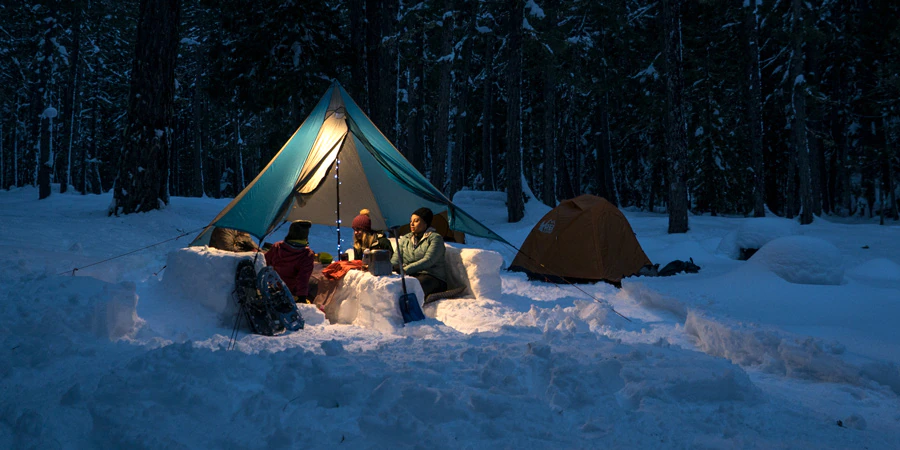
Winter camping has its perks. There are fewer bugs and crowds while you experience the beauty and peacefulness of a pristine winter wonderland. But, if you’re not prepared, it can also be cold and challenging. To set yourself up for a successful winter campout, you’ll want to build on your knowledge of fair-weather camping while adjusting for the additional challenges of cold temperatures, snowy landscapes and unpredictable weather.
Here are the main things to think about when camping in winter:
- Tips for making camp in the snow: Pick a spot that’s sheltered from the wind and free of avalanche danger, then prep your tent site by packing down the snow.
- Stay hydrated and eat lots of calories: Proper nutrition and hydration will help you stay warm. Make hot, nutritious breakfasts and dinners and enjoy quick snacks and lunches. Be sure to hydrate throughout the day.
- Use gear that’s right for winter camping: You’ll need a sturdy tent, a warm sleeping bag, two sleeping pads and a stove suitable for cold temperatures.
- Bring warmer clothing: Midweight base layers, fleece pants, a puffy coat, and a waterproof jacket and pants are standard. Don’t forget accessories like warm socks, a hat, gloves and sunglasses.
- Prevent cold injuries: Frostbite and hypothermia are legitimate concerns while winter camping. Learn how to avoid them.
- Additional tips: Eating food, filling a bottle with hot water and doing jumping jacks are just a few tips for staying warm on a cold night.
Making Camp in the Snow
Perhaps the biggest difference between summertime camping and winter camping is the possibility that you’ll be camping on snow (assuming you live somewhere near where it snows). When you reach your destination for the day, rather than immediately unpacking, take some time to find the right camp spot. Relax, have a snack, put on some warm clothing layers and examine the area for these things:
- Wind protection: A natural wind block, like a group of trees or a hill, can make your experience more comfortable.
- Water source: Is there a good water source nearby, or will you need to melt snow?
- Avoid camping on vegetation: In patchy snow conditions, set up camp on the snow or an established campsite of bare ground.
- Avalanche risk: Make sure you’re not on or below a slope that could slide.
- Hazard trees: Don’t setup underneath unstable or damaged trees or limbs.
- Privacy: It’s nice to have some distance between you and other campers.
- Where the sun will rise: A spot that offers exposure to sunrise will help you warm up faster.
- Landmarks: Keep an eye out for landmarks to help you find the camp in the dark or a snowstorm.
Setting Up a Tent on Snow
While it’s possible to build a snow shelter, such as a quinzhee or igloo, most beginner snow campers will spend the night out in a tent (see the Essential Gear for Winter Camping section of this article for information on choosing a tent). If you won’t be on snow, set up your tent just like you always do. If you will be on snow, here are some tips:
- Pack down the snow: Loose snow is more likely to be melted by your body and make it uncomfortable for sleeping. Before setting up your tent, walk around with your snowshoes or skis on your feet, or you can stomp around in your boots.
- Build a wall: If it’s windy, build a snow wall around your tent if possible. If it’s not feasible to do so, then dig out the snow a couple of feet down for your tent and vestibule. This helps to reduce wind impact. Don’t completely seal up your tent though. It still needs to receive sufficient ventilation.
- Dig out your vestibule: You can dig out a bench underneath your tent’s vestibule to create more space for stowing gear and to make it easier to get in and out of your tent.
- Use snow stakes: Standard tent stakes won’t do much good in snow. Instead, bury stuff sacks filled with snow or use stakes designed for use in snow. Make sure your tent is staked out securely so it won’t blow away if the wind picks up.
- Stay away from sharps: Keep any item that could tear your tent well away from your shelter and do not bring them inside. This includes items like ice axes, crampons and ski edges. Ripping your tent on a stormy winter day can be disastrous.
Continue reading here – https://www.rei.com/learn/expert-advice/winter-camping.html
